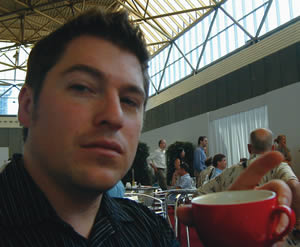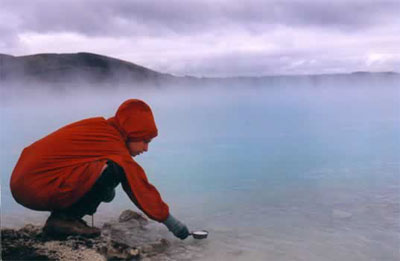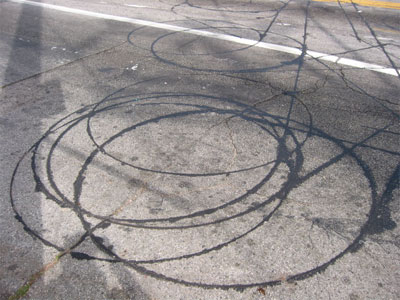
Lauren Cornell: Nato, thank you for agreeing to do this interview with me. Lets start off with a simple question. Read anything good lately?
Nato Thompson: I have been reading awful science fiction with incredible cover art from the 70s. I'm not usually such an aesthete when it comes to reading, but I am in an anti-theory mood lately.
LC: I understand. Now, lets bring out some context for your work as a curator. When you organized this show, you were in between Creative Time in New York and Mass MoCA. Something that seems consistent in your work, as you operate inside and outside of institutions, is an interest in the connections between art and larger politics or cultural change. But maybe this isn't how you see it. What, if anything, would you say guides your work as a curator?
NT: I have always held the political angle of the avant-garde as a necessary and important history. The political drive behind those ambitious enough to make their dreams a reality does not come out of an interest in art per se, but the interest in producing meaning on a large level. A basic Marxist idea (that I think is quite apparent) is that the way we think is produced in the way we live. So, those interested in producing a more robust form of living must take seriously the economic and social forms that produce our world. These are hardly separate projects.
But I must qualify, that this trajectory isn't in terms of pure ambition but, ultimately, in interrogating the social forms that produce our world. It might sound naïve, but I still am hopeful that we can find a way to produce a system of organization which guarantees equal rights for every one on the planet. At times, artists are interested (not always in the most straightforward methods) in producing this type of world. In others, their actions point toward liberatory gestures and forms of meaning that are resistant in their buoyancy.
Institutional critique was a necessary maneuver to show that the art world, like all other forms of discourse, is run via power. The next step is to contextualize this framework among the various other discourses and try to lay out a specifically strategic campaign for meaning production. It seems naïve to point out that power solely lives in institutions. It is everywhere!
LC: Your recent show "Experimental Geography" seems to me like an informal survey of artists working with mapping. It includes artists/ collectives that have been engaged with alternate cartographies for a long time, as well as new approaches. Certainly, it captures the energy and activity in this area. My first question for you is- why do you think there is so much work being done with "experimental geography" now?
NT: Actually, it isn't only artists working with cartography although there is plenty of that. The exhibition is more about a broad sense of geography ranging from the geologic to the urban, from the didactic to the poetic. I agree we live in a bizarre but compelling cartography zeitgeist. Maps seem to be everywhere! Chicago just had a festival of maps and museums all over the city have cartographic exhibitions. This project is certainly related but I am hoping to push the category beyond visualizing of information and space. Artist Yin Xiuzhen produces these sewn cities that emerge from a suitcase. Artist Ilana Halperin boils milk in the steam of a hot spring. There are more, but the idea is that the field of experimental geography (a phrase coined by one of the artists in the exhibition, Trevor Paglen) is more about the interpretation of space in a variety of forms.

In terms of why the field itself seems to be growing (in particular cartography), I would hazard to say that inter-disciplinary practices are still finding their feet. Artistic production, as it wades its way through a variety of disciplines, is best at discovering new forms for conveying ideas or impulses. Not only in the field of two-dimensional imagery but also in walking tours, sound art, video installation, lectures. The ability to play with a form allows those that produce knowledge to bring information to a viewer in a more compelling manner, and also to interrogate the possibility that ambiguity is a productive intellectual tool. Ambiguity (that favorite tool of art) often feels antithetical to a practice of empiricism, but in fields where the post-modern turn has truly sunk in its teeth (like geography), ambiguity becomes a productive tool for engaging a variety of perspectives. Because geography has taken on the broad understanding that the world creates us, and we (people) create the world, it has been more susceptible to complicated forms of knowledge presentation.
LC: I would agree that inter-disciplinary practices are finding their feet and becoming more prevalent. I think this tendency reflects, in part, a culture structured by, as scholar Henry Jenkins puts it, "convergence culture" or the convergence of ideas distributed across many different platforms. Projects, even people, can exist simultaneously, if slightly varied, in multiple contexts at the same time. Media art manifests in endless forms, in some cases one piece will exist as an installation, a lecture and online and yet have the coherence of a single work of art. Specifically, for "Experimental Geography", what kind of outside non-artistic practices do you see encouraging this kind of work?
NT: The field of geography became quite inspirational to many practitioners I know. Starting with writers like Henry LeFebre and Michel DeCerteau and even the Situationists for that matter. Particularly, their interest in being ambulatory in the city and the way in which one negotiates the forces which structure movement. The city is a space that produces us. These thinkers began to pave the way for a new form of practice. Then writers like Edward Soja, Manuel Castells, and Mike Davis began to write about the city and economies in a way that pointed to specific instances which exemplified the concept that ideas exist in space. Most wrote about Los Angeles, but the effort to situate theory appealed to those coming out of an increasingly abstract post-modern hangover. After Derrida, it felt good to be able to walk to a street corner and say, here is a story of how power operates here. This method of interrogation was surely inspirational to the highly influential Center for Land Use Interpretation who tackled the forms of site-seeing as a medium to bring the mystery that is the built-environment forward to an audience. It is unnecessary to call it art. It is an investigation (both poetic and didactic) of the world we live in.

LC: Are these ideas what motivated you to organize this show?
NT: I am a believer in the impact of cultural production. I have never been a fan of the myopia by which most contemporary art is understood as a specific discourse tucked inside the much larger cultural fields. Let's bring in the whole bag of cultural production since the production of information in all its forms is not only a major form of capital, but also a primary manner in which we understand the world. "Experimental Geography" is an opportunity to test out some ideas of a truly inter-disciplinary practice that produces new rules and expectations. As much as it can be interpreted from the lens of contemporary art, it benefits from the lens of multiple other disciplines as well. It is a beginning effort in trying to imagine what an institution that studies the world in a variety of forms and that embraces ambiguity and didacticism might look like. It is too reductive to say a neo-wunderkammen, but it gets closer to the point. It is an effort to imagine new forms of thinking after the collapse of the rigid walls of the enlightenment.
LC: Many of these works address notions of territory, land and borders. Do you think they provide new forms of thinking about international relationships or the tired concept of "globalization" -- which rings of corporate marketing, 90s Clintonian idealism and the idea that roots lack significance.
NT: I wouldn't say that globalization is just that, but surely that is one of them. I mean it was also a way for looking at how markets have expanded under neoliberalism. In fact, the protests in Seattle were a result of an expanded notion of capital as placed in large economic structures like the WTO and World Bank. I think the question of borders comes up and they are productive. When Multiplicity looks at the specific time it takes to drive across Israel as a Palestinian and as an Israeli, it is clearly dealing with the politics of how space is carved up. Clearly discussing the occupied territories is a political and geographic question that makes space and power come together quite deftly. I guess what is particularly poetic, is that for many folks, space and power are different concepts and art projects can do a lot to make it more clear how deeply intertwined they are.
LC: At a recent talk that Rhizome held at the New Museum (entitled Nextcity: the Art of the Possible), Eric Rodendeck from Stamen Design called data visualization "a medium". It seemed appropriate to me to frame it this way as picturing information--be it geographic, historic, cultural--is such a powerful way of understanding and conveying the world that, therefore, its essential that it be visualized in multiple ways. Do you see overlap with data visualization and the various approaches to geography presented in EG having the same longevity? I'm thinking specifically of Trevor Paglen's work here�but perhaps its connected to other works in the show as well.
NT: I am mixed in my feelings on this. I think that there is an abundance of information visualizing. I suspect that its emergence has more to do with an interest in deploying the fields of one school of thought toward another. That is, for example, net based activism communities using mapping to understand the power structures that be. Or, alternative cartographic maps of displaced communities. I think while the maps are useful to some degree, they come out of an excitement at finding a productive interdisciplinary practice. You can already sense an exhaustion with mapping as we speak. We could be buried in multiple methods for understanding the complexities around us. Nonetheless, I am interested in its continuance. I suspect a weeding out of works will have to occur where people become more selective of what forms of data visualization they find productive or fascinating. There are plenty of absolutely annoying mapping projects out there that feel like architecture students using software to visualize information in an absolutely uninteresting if not incomprehensible manner. But, of course, the political goal is much more enjoyable. If you want to get somewhere, you need a map.
It is interesting that you bring up Trevor's project because I think of his particular set of work as very different than most experimental geography practitioners. His work, I think, productively interrogates the methods that power uses in terms of the visual. That is to say, his work comes out of a simple idea: seeing is believing. So, if the United States hides its prisons, do they exist? This basic line of interrogation (this is one of many), allows us to consider not just photography as a medium of truth telling, but the spatialization of the visual that the US government or power in general, deploys.
LC: I imagine many of these would sit uncomfortably in the gallery--as I know many of the artists' previous projects have included tours or disparate, sometimes networked experiences--not necessarily objects. Can you describe the installation of this show and how it will change as it progresses through different venues?
NT: A big part of my job is to be a showmaker. I need to move people through space via the work in the exhibition. So, I have worked with ICI to produce a project that fits well in a gallery. I have a hunch that many curators that take on these types of interdisciplinary shows lack a certain sense of the seductive. A field like Experimental Geography can easily appeal to the most ascetic of nerds who can't help but fetishize archives and maps. A show of maps and data everywhere- what a nightmare! So, this project attempts to break up that rhythm by vacillating between tone and emotion. Didactic works can actually be edifying, but not if they are the seventh didactic project in a row. The work of Center for Land Use Interpretation will not hum if they are surrounded by tons of studies of spaces in the U.S. They need to remain particular, as do all the works. So, the exhibition runs the gamut of forms with video, sculpture, sound, and maps.
I think you are right that the exhibition would benefit from tours and more participatory projects, but these might not be feasible for some venues. It really depends. Participatory work is hard to put in a box and ship, but it is also one of my favorite types of practice.
LC: Were the works made especially for the show?
NT: Every work in the exhibition previously existed. Some were modified for the purposes of exhibition.
LC: Last, Nato, where next for you?
NT: I am currently working on a project for Creative Time called Democracy in America which unfolds throughout 2008. It is a three-part project that, because I am working with a public arts organization, has the ability to take on a peculiar and exciting form. This project comes at the close of the Bush era, and in a way it is a method to take stock of us as a society. Clearly the country is ready for something new, but at the same time, we must ask ourselves, what happened? The first two parts of the project involve a sort of gathering research with small discussions in five cities, and three wonderful national commissions with artists Sharon Hayes, Mark Tribe, and Rodney McMillan and Olga Koumoundouros. The final state will be a roving space for participation and reflections on democracy to set sail in September and October. It is going to be phenomenal and I am eager to see that come to life.